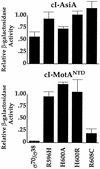The bacteriophage T4 transcription activator MotA interacts with the far-C-terminal region of the sigma70 subunit of Escherichia coli RNA polymerase
- PMID: 12081968
- PMCID: PMC135182
- DOI: 10.1128/JB.184.14.3957-3964.2002
The bacteriophage T4 transcription activator MotA interacts with the far-C-terminal region of the sigma70 subunit of Escherichia coli RNA polymerase
Abstract
Transcription from bacteriophage T4 middle promoters uses Escherichia coli RNA polymerase together with the T4 transcriptional activator MotA and the T4 coactivator AsiA. AsiA binds tightly within the C-terminal portion of the sigma70 subunit of RNA polymerase, while MotA binds to the 9-bp MotA box motif, which is centered at -30, and also interacts with sigma70. We show here that the N-terminal half of MotA (MotA(NTD)), which is thought to include the activation domain, interacts with the C-terminal region of sigma70 in an E. coli two-hybrid assay. Replacement of the C-terminal 17 residues of sigma70 with comparable sigma38 residues abolishes the interaction with MotA(NTD) in this assay, as does the introduction of the amino acid substitution R608C. Furthermore, in vitro transcription experiments indicate that a polymerase reconstituted with a sigma70 that lacks C-terminal amino acids 604 to 613 or 608 to 613 is defective for MotA-dependent activation. We also show that a proteolyzed fragment of MotA that contains the C-terminal half (MotA(CTD)) binds DNA with a K(D(app)) that is similar to that of full-length MotA. Our results support a model for MotA-dependent activation in which protein-protein contact between DNA-bound MotA and the far-C-terminal region of sigma70 helps to substitute functionally for an interaction between sigma70 and a promoter -35 element.
Figures








Similar articles
-
Transcriptional control in the prereplicative phase of T4 development.Virol J. 2010 Oct 28;7:289. doi: 10.1186/1743-422X-7-289. Virol J. 2010. PMID: 21029433 Free PMC article. Review.
-
The bacteriophage T4 inhibitor and coactivator AsiA inhibits Escherichia coli RNA Polymerase more rapidly in the absence of sigma70 region 1.1: evidence that region 1.1 stabilizes the interaction between sigma70 and core.J Bacteriol. 2006 Feb;188(4):1279-85. doi: 10.1128/JB.188.4.1279-1285.2006. J Bacteriol. 2006. PMID: 16452409 Free PMC article.
-
Transcriptional takeover by sigma appropriation: remodelling of the sigma70 subunit of Escherichia coli RNA polymerase by the bacteriophage T4 activator MotA and co-activator AsiA.Microbiology (Reading). 2005 Jun;151(Pt 6):1729-1740. doi: 10.1099/mic.0.27972-0. Microbiology (Reading). 2005. PMID: 15941982 Review.
-
Mutational analysis of sigma70 region 4 needed for appropriation by the bacteriophage T4 transcription factors AsiA and MotA.J Mol Biol. 2006 Nov 10;363(5):931-44. doi: 10.1016/j.jmb.2006.08.074. Epub 2006 Aug 30. J Mol Biol. 2006. PMID: 16996538 Free PMC article.
-
A family of anti-sigma70 proteins in T4-type phages and bacteria that are similar to AsiA, a Transcription inhibitor and co-activator of bacteriophage T4.J Mol Biol. 2004 Dec 10;344(5):1183-97. doi: 10.1016/j.jmb.2004.10.003. J Mol Biol. 2004. PMID: 15561138
Cited by
-
The phage T4 MotA transcription factor contains a novel DNA binding motif that specifically recognizes modified DNA.Nucleic Acids Res. 2018 Jun 1;46(10):5308-5318. doi: 10.1093/nar/gky292. Nucleic Acids Res. 2018. PMID: 29718457 Free PMC article.
-
Architecture of the bacteriophage T4 activator MotA/promoter DNA interaction during sigma appropriation.J Biol Chem. 2013 Sep 20;288(38):27607-27618. doi: 10.1074/jbc.M113.475434. Epub 2013 Jul 31. J Biol Chem. 2013. PMID: 23902794 Free PMC article.
-
A regulator that inhibits transcription by targeting an intersubunit interaction of the RNA polymerase holoenzyme.Proc Natl Acad Sci U S A. 2004 Mar 30;101(13):4554-9. doi: 10.1073/pnas.0400923101. Epub 2004 Mar 22. Proc Natl Acad Sci U S A. 2004. PMID: 15070756 Free PMC article.
-
Determinants of affinity and activity of the anti-sigma factor AsiA.Biochemistry. 2010 Jul 27;49(29):6143-54. doi: 10.1021/bi1002635. Biochemistry. 2010. PMID: 20545305 Free PMC article.
-
Transcriptional control in the prereplicative phase of T4 development.Virol J. 2010 Oct 28;7:289. doi: 10.1186/1743-422X-7-289. Virol J. 2010. PMID: 21029433 Free PMC article. Review.
References
-
- Brody, E., D. Rabussay, and D. Hall. 1983. Regulation of transcription of prereplicative genes, p. 174-183. In C. K. Mathews, E. M. Kutter, G. Mosig, and P. B. Berget (ed.), Bacteriophage T4. American Society for Microbiology, Washington, D.C.
-
- Busby, S., and R. Ebright. 1999. Transcription activation by catabolite activator protein (CAP). J. Mol. Biol. 293:199-213. - PubMed
-
- Campbell, E. A., O. Muzzin, M. Chlenov, J. L. Sun, C. A. Olson, O. Weinman, M. L. Trester-Zedlitz, and S. A. Darst. 2002. Structure of the bacterial RNA polymerase promoter specificity sigma subunit. Mol. Cell 9:527-539. - PubMed
Publication types
MeSH terms
Substances
Grants and funding
LinkOut - more resources
Full Text Sources

